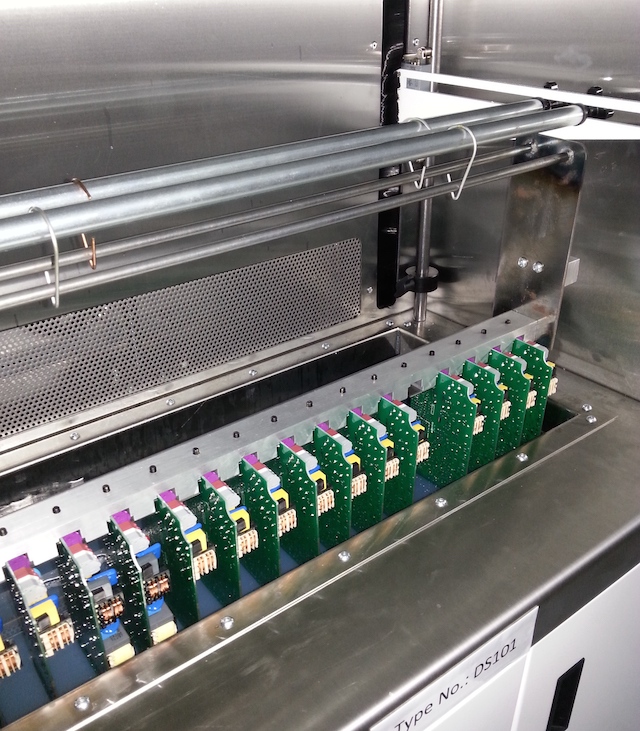
Applying clear design guidelines for dip-applied conformal coating can dramatically simplify the coating process, reduce defects, and prevent costly production delays.
When boards are designed specifically with immersion coating behaviour in mind, manufacturers benefit from more consistent coverage, easier masking, and far fewer downstream issues on the production line.
Key design rules for dip-applied conformal coating
When designing printed circuit boards for dip conformal coating, attention to layout, handling, drainage, and fixture interaction is critical. The following practical guidelines should be considered at both the PCB and tooling design stage:
- Group masked components at one end of the PCB. Place connectors and keep-out features so the board can be dipped to a controlled depth without coating sensitive areas.
- Define secure handling points. Ensure the PCB can be reliably held or fixtured without contacting coated or functional areas.
- Prevent fixture contamination. Fixtures should avoid entering the coating bath and must not accumulate coating over repeated cycles.
- Match coating chemistry to the dip process. Confirm viscosity, cure mechanism, and material compatibility are suitable for immersion coating.
- Design for controlled drainage. Allow the board to drain toward a defined edge or corner to minimise pooling and excessive thickness build-up.
- Avoid components that trap coating. Select components and orientations that allow coating to drain freely during withdrawal.
- Choose masking-friendly components. Where masking is required, use connectors and parts that can be easily protected using boots, caps, or standard masking solutions.
For a deeper technical discussion – including designing PCBs and assemblies for coating, including keep-out zones, component spacing, creepage and clearance, and applying DfM/DfCC principles before manufacture go to our conformal coating design hub.
Why use conformal coating design rules?
Well-defined design rules for conformal coating significantly reduce cost, process risk, and production disruption while improving coating quality and long-term reliability.
Although many principles apply across all coating technologies, each application method introduces process-specific design constraints that must be addressed early in the design stage.
- General design fundamentals – geometry, drainage paths, handling points, and coating access
- Selective robotic coating – valve access, shadowing, programming tolerances, and keep-out definition
- Dip coating – orientation, drainage control, fixture interaction, and thickness build-up
- Batch spray coating – coverage consistency, overlap zones, and edge definition
- Parylene coating – vapour access, clearances, masking strategy, and material compatibility
Many of these rules overlap across processes, while others are highly application-specific. Understanding where design decisions influence coating behaviour helps engineers avoid rework, reduce masking complexity, and ensure the selected coating process is robust, repeatable, and scalable.
Why conformal coating problems often start at the design stage
Most manufacturers have successfully adopted Design for Manufacture (DFM) principles, improving communication between design teams and production to reduce avoidable challenges.
However, conformal coating is frequently treated as a simple material selection rather than a process-dependent manufacturing operation. Too often, coating is reduced to a part number applied late in the design cycle.
For organisations applying lean manufacturing principles, this lack of early consideration can result in assemblies that are difficult—or impossible—to coat as specified, regardless of equipment capability.
Fortunately, conformal coating design rules are straightforward. When applied early, they save both time and money. When ignored, even the most advanced coating systems can struggle to achieve the required finish.
In nearly all cases, these “nightmare” production scenarios could have been avoided during the design review or prototyping stage.
Get expert help selecting the right conformal coating process
If you are evaluating conformal coating methods or experiencing application challenges, SCH can help review your design and recommend the most suitable coating process, equipment, and masking strategy.


